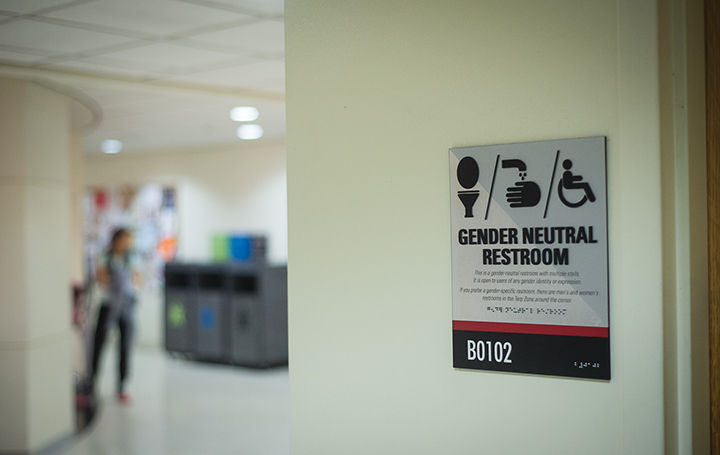
Gender neutral bathroom inside of Stamp Student Union
As a transgender student at this university, Max Balagtas-Badoy grapples with concerns over safety when using the restroom, he said in a written testimony to the SGA’s legislature Wednesday night.
“While I felt safer using the women’s [restrooms],” read Johanna DeGuzman for Balagtas-Badoy, who was not present, “it was still distressing to have other students scrutinize me for my gender and, consequently, my right to be in the restroom.”
To address his daily struggle, Balagtas-Badoy — and the majority of the Student Government Association — support the construction and implementation of increased gender-neutral bathroom facilities on the campus. Last night, the SGA passed three resolutions urging both Facilities Management and University Recreation and Wellness to study the feasibility of putting gender-neutral bathrooms in campus dorms and dining halls, Ritchie Coliseum and Eppley Recreation Center.
The final votes were 23 – 2 with two abstentions, 22 – 3 with one abstention and 23 – 2 with two abstentions, respectively.
Gender-neutral bathrooms, available to anone, particularly benefit nonbinary gender people, a segment of the population who can face safety issues in bathrooms, said Nicholas Sakurai, leadership initiatives director for the LGBT Equity Center.
Such facilities can be multi-user or single-user but always remove the gender labeling from the door. This diffuses tensions some students feel when using binary-labeled restrooms — part of the motivation for the SGA’s bill.
“People can be yelled at or harassed for trying to use the restroom, or they can be asked personal questions and forced to defend their identities when all they want to do is use the bathroom,” Sakurai said. “They’re being profiled based on how they appear, and it can be very problematic.”
After a meeting with university President Wallace Loh’s cabinet and Rise Above “-isms” week in October, DeGuzman and the committee on diversity and inclusion decided to move forward with the legislation.
READ MORE: Students reflect on identity, social change for LGBT History Month
The cabinet “was really receptive to what I was saying and the issues we had brought to them about it,” DeGuzman said. “What we’re trying to do is get the conversation started around creating gender-neutral bathrooms instead of converting the bathrooms we already have.”
A bathroom in Stamp Student Union was converted into a multi-user gender-neutral bathroom during the 2012-13 academic year and contains stalls around the urinals, in addition to guards in between the spacings on the stalls for added privacy.
The resolution also calls for more access to gender-neutral showering facilities in dorms and the two gyms. Currently, there is at least one single-user shower in gym facilities on the campus, but through the bill, the SGA hopes to increase availability.
If a student is not comfortable using the general showers in the high-rise dorms, they can request through Resident Life to be moved to a dorm with a private bathroom.
“We realized there is a lot of intersectionality within the students here,” DeGuzman said. “The transgender community here at Maryland really doesn’t get the resources that they deserve and every other student does have.”
In addition to the university’s current gender-neutral restrooms, Sakurai praised the University Health Center’s bathroom signage, which directs users to the gender-neutral bathroom options at each bathroom location as they are not always easily located.
Still, Sakurai said, there is “definitely more” the university as a whole could do to increase bathroom accessibility and inclusivity.
“There are good practices that, as an institution, we need to look at: How accessible is the bathroom? How far do you have to walk or go to find one?” they said, adding that the university could consider adding new guidelines to ensure users would not have to walk extremely long distances.
READ MORE: University Senate committee debates allowing preferred pronouns
While this university is required to include gender-neutral bathroom facilities in any newly constructed or renovated buildings, the University of California system crafted a policy last year calling for all existing buildings to include gender-neutral facilities. The policy expands upon this university’s and both LGBT Equity Center Director Luke Jensen and Sakurai pointed to as a positive step forward.
This university’s Facilities Management has incorporated gender-neutral bathrooms into the designs of recently built, planned to be built and renovated buildings on the campus, including Prince Frederick Hall, Edward St. John Teaching and Learning Center, Cole Field House and A. James Clark Hall.
Additionally, Bill Olen, the university’s capital projects director, said several single-occupancy bathrooms have been included into the Tawes and Cambridge halls renovations.
In 2014, the SGA drafted a bill to include at least one gender-neutral bathroom in each campus building after finding that there were only 66 gender-neutral bathrooms on the campus. The bathrooms were in 14 of 67 academic buildings and were not in every dorm.
It was not ultimately sent to Facilities Management or the senate after research found that it was cost-prohibitive to convert bathrooms in existing buildings, said Aiden Galloway, SGA speaker of the legislature.
However, Olen said in an interview Tuesday that Facilities Management is open to accommodating, despite the logistical difficulty in building new bathrooms in existing buildings as opposed to constructing them with new ones.
“Space that’s assigned to someone else in that building will have to be given up for this use,” Olen said. “But can it be done? Yes. It’s not impossible.”



